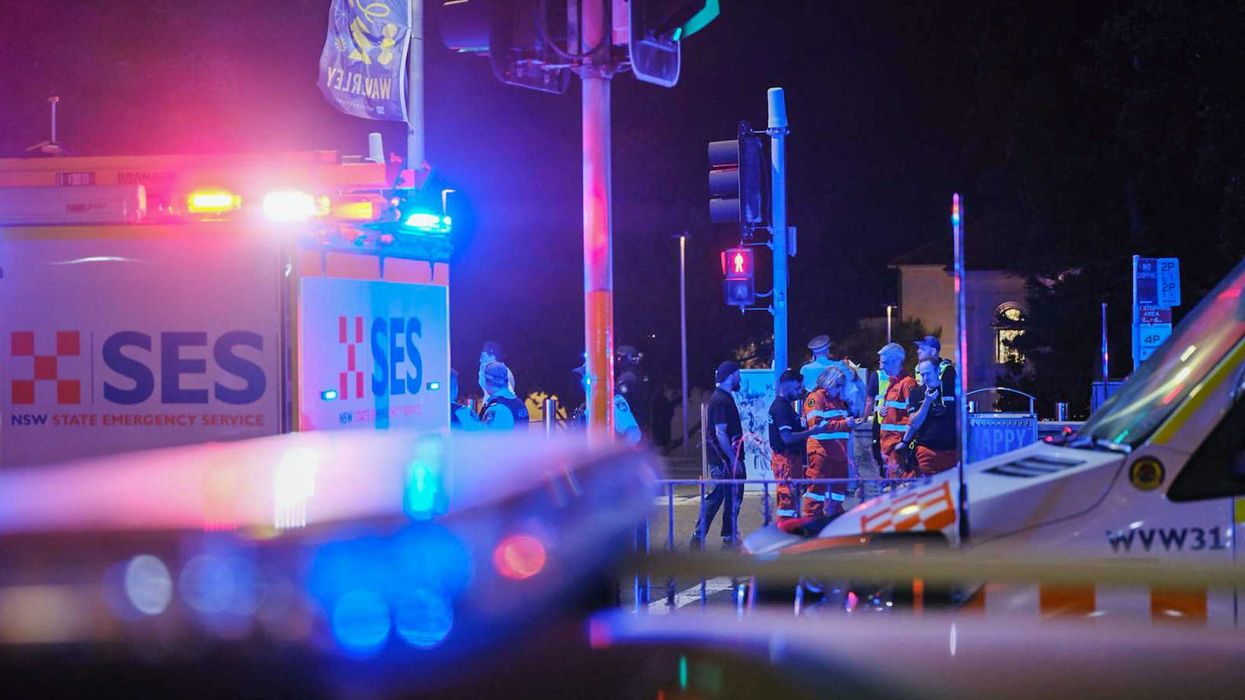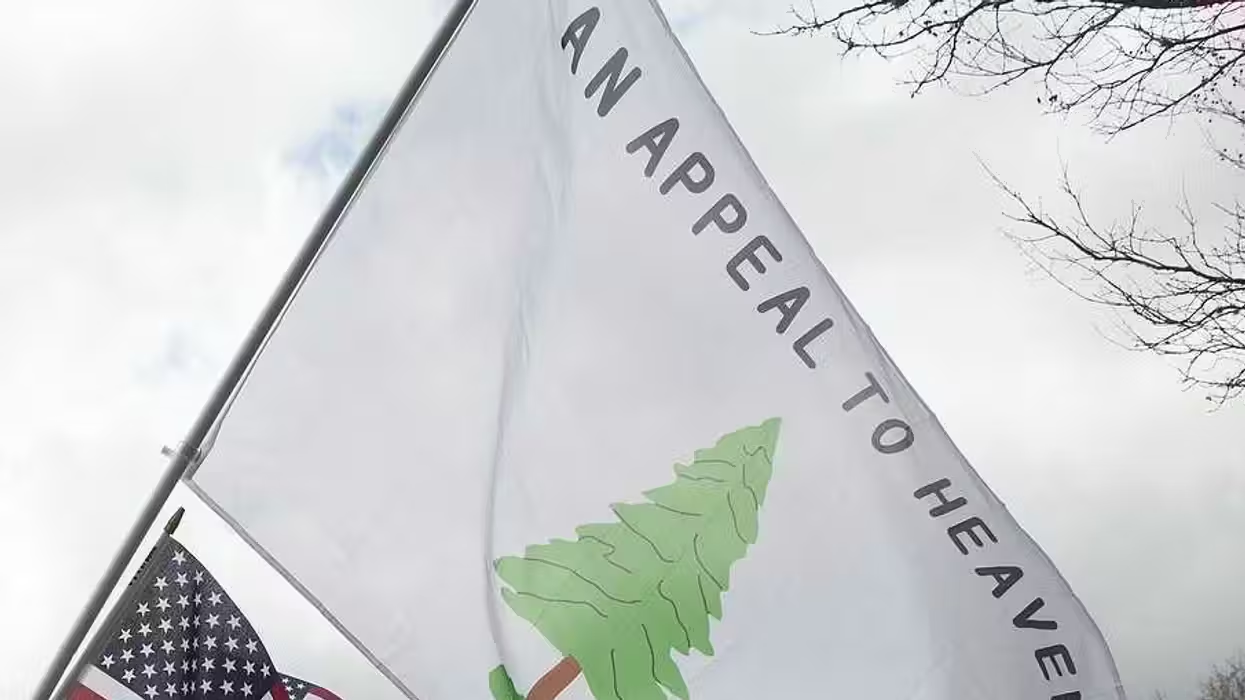PAHOA, Hawaii (TheBlaze/AP) — Denise Lagrimas never thought she'd be leaving her single story home and moving 14 miles away to avoid molten lava.
"It's so surreal, it's so surreal. Never in my wildest dreams as a kid growing up did I think I would be running from lava," Lagrimas said.
Denise and her husband Jeff Lagrimas home is just across the street from properties where lava from Kilauea volcano is expected to slither past on its way to the ocean.
"I don't want to stick around and just wait for it to come and take it," Denise Lagrimas said while taking a break from loading kitchen cups and bowls in cardboard boxes. "You just never know."
Civil defense officials in Hawaii County said late Tuesday the lava was about 370 yards from the main road in Pahoa town, the commercial center of Puna, a sprawling, mostly agricultural and forested part on the Big Island.
Here's a look at some of the lava flow that has locals evacuating:
 This Tuesday, Oct. 28, 2014 photo provided by the U.S. Geological Survey shows lava that has pushed through a fence marking a property boundary above the town of Pahoa on the Big Island of Hawaii.
This Tuesday, Oct. 28, 2014 photo provided by the U.S. Geological Survey shows lava that has pushed through a fence marking a property boundary above the town of Pahoa on the Big Island of Hawaii.
 Residents of the small town have had weeks to prepare for what's been described as a slow-motion disaster. County officials are making arrangements for those living in the lava's path to be able to watch the lava destroy their homes as a means of closure. (AP/U.S. Geological Survey)
Residents of the small town have had weeks to prepare for what's been described as a slow-motion disaster. County officials are making arrangements for those living in the lava's path to be able to watch the lava destroy their homes as a means of closure. (AP/U.S. Geological Survey)
 The lava flow easily burned down an empty shed at about 7:30 a.m., several hours after entering a residential property in Pahoa Village, said Hawaii County Civil Defense Director Darryl Oliveira. (AP/U.S. Geological Survey)
The lava flow easily burned down an empty shed at about 7:30 a.m., several hours after entering a residential property in Pahoa Village, said Hawaii County Civil Defense Director Darryl Oliveira. (AP/U.S. Geological Survey)
 This Oct. 26, 2014 photo provided by the U.S. Geological Survey a Hawaii Volcano Observatory geologist mapping the margin of the June 27 lava flow in the open field below Cemetery Road near the town of Pahoa on the Big Island of Hawaii. (AP /U.S. Geological Survey)
This Oct. 26, 2014 photo provided by the U.S. Geological Survey a Hawaii Volcano Observatory geologist mapping the margin of the June 27 lava flow in the open field below Cemetery Road near the town of Pahoa on the Big Island of Hawaii. (AP /U.S. Geological Survey)
 The flow front passed through a predominantly Buddhist cemetery, covering grave sites in the mostly rural region of Puna, and was roughly a half-mile from Pahoa Village Road, the main street of Pahoa. (AP/U.S. Geological Survey)
The flow front passed through a predominantly Buddhist cemetery, covering grave sites in the mostly rural region of Puna, and was roughly a half-mile from Pahoa Village Road, the main street of Pahoa. (AP/U.S. Geological Survey)
 The USGS says the flow is currently about 160 to 230 feet (50 to 70 meters) wide and moving northeast at about 10 yards (nine meters) per hour. It's currently about six-tenths of a mile (one kilometer) from Pahoa Village Road, the town's main street. (AP/U.S. Geological Survey)
The USGS says the flow is currently about 160 to 230 feet (50 to 70 meters) wide and moving northeast at about 10 yards (nine meters) per hour. It's currently about six-tenths of a mile (one kilometer) from Pahoa Village Road, the town's main street. (AP/U.S. Geological Survey)
 A portion of the front of the June 27th lava flow burns through thick vegetation and a fence on October 26, 2014 in Pahoa, Hawaii. Scientists of the Hawaiian Volcano Observatory conducted ground and air observations of the lava flow from the Kilauea Volcano and determined that it was 510 meters (560 yards) upslope from Pa-hoa Village Road and the flow width was about 50 meters (55 yards) at the leading edge. (Handout/Getty Images)
A portion of the front of the June 27th lava flow burns through thick vegetation and a fence on October 26, 2014 in Pahoa, Hawaii. Scientists of the Hawaiian Volcano Observatory conducted ground and air observations of the lava flow from the Kilauea Volcano and determined that it was 510 meters (560 yards) upslope from Pa-hoa Village Road and the flow width was about 50 meters (55 yards) at the leading edge. (Handout/Getty Images)
 In this Oct. 22, 2014 photo provided by the U.S. Geological Survey, a geologist marks the coordinates of the Kilauea lava flow front with a GPS unit. A 13-mile finger of lava from Kilauea Volcano has started to again move quickly, and could hit a secondary road sometime Friday, Oct. 24, 2014. Officials on Hawaii's Big Island won't start evacuating people until the lava flow is within three to five days of affecting Pahoa residents. (AP /U.S. Geological Survey)
In this Oct. 22, 2014 photo provided by the U.S. Geological Survey, a geologist marks the coordinates of the Kilauea lava flow front with a GPS unit. A 13-mile finger of lava from Kilauea Volcano has started to again move quickly, and could hit a secondary road sometime Friday, Oct. 24, 2014. Officials on Hawaii's Big Island won't start evacuating people until the lava flow is within three to five days of affecting Pahoa residents. (AP /U.S. Geological Survey)
The lava entered private property next to the main road and was burning tires and other materials. This prompted authorities to warn downwind residents with respiratory problems to stay indoors. The lava was edging forward at a rate of about 10 to 15 yards per hour.
Earlier Tuesday, the lava burned down an empty shed.
Watch this footage of the "slow-motion disaster" with residents talking about their evacuation plans:
Here's more raw footage:
The lava picked up speed last week after weeks of slow, stop-and-go movement. It broke out of forest and pastureland and crossed into inhabited areas for the first time since scientists began warning about lava in August.
Pahoa residents have had weeks to prepare for what's been described as a slow-motion disaster. Most have either already left or are prepared to go.
At least 50 or 60 structures — including homes and businesses — are in an area civil defense officials are currently warning will likely be hit.
Josiah Hunt, who has farm in a part of Puna that is not immediately threatened, described smelling burning grass, feeling warmth from the lava and hearing "popping and sizzling and all the methane bursts that are happening in the distance ... mixed with the birds chirping and the coqui frogs."
The Lagrimas family decided to move to Kurtistown, a safe distance from Kilauea's current flow.
"We didn't want to go anywhere where it's close enough where we would have to evacuate again," she said.
 Here's the latest lava flow map. (Image source: USGS)
Here's the latest lava flow map. (Image source: USGS)
The Lagrimases are also worried the lava will block roads leading out of Pahoa and prevent them from commuting to their jobs in Hilo. Then there's the prospect of subsequent flows gradually swallowing more of the community, which is what happened to the Royal Garden and Kalapana subdivisions in the 1980s and 1990s.
Some people want to watch the lava destroy their homes as it's one way to cope with the loss.
"You can only imagine the frustration as well as ... despair they're going through," said Hawaii County Civil Defense Director Darryl Oliveira.
Hunt watched last week as the lava crept toward Pahoa and saw a woman whose house is near its path put a lei at the front of the flow. "It helps a person come to grips with the reality of the situation," he said. "I found it to be oddly comforting in a really strange way."
Terri Mulroy, who runs Kumu Aina Farm with her husband, said the lava flow, while unnerving, has a cleansing quality to it because it keeps development on the lush Hawaiian island in check.
"If it wasn't for the flow, I wouldn't be able to live here," she said. "This land would have been a golf course for the rich."

 This Tuesday, Oct. 28, 2014 photo provided by the U.S. Geological Survey shows lava that has pushed through a fence marking a property boundary above the town of Pahoa on the Big Island of Hawaii.
This Tuesday, Oct. 28, 2014 photo provided by the U.S. Geological Survey shows lava that has pushed through a fence marking a property boundary above the town of Pahoa on the Big Island of Hawaii.






